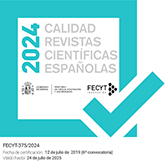Coronal stop lenition in French and Spanish: Electropalatographic evidence
DOI:
https://doi.org/10.3989/loquens.2021.080Keywords:
lenition, voiceless and voiced coronal stops, French, SpanishAbstract
Lenition of voiced and, to a lesser extent, voiceless stops is widely attested in Western Romance languages. In Spanish, utterance-initial voiced stops as well as those following nasals alternate with approximants in intervocalic position. Acoustic and articulatory studies have revealed factors that condition phonetic weakening. In contrast, very little is known about stop weakening in French. In this paper, using electropalatography, we provide articulatory evidence for the lenition of /t d/ in both Spanish and French. Data obtained from seven Spanish-speaking and four French-speaking participants reveal that, in both languages, /d/ is produced with less linguopalatal contact than /t/, and these differences are strongly conditioned by the position within the utterance or word. The languages differ, however, in the degree of /d/ lenition as well as in some of the contextual conditioning factors. Overall, our results, which should be interpreted with some caution given the number of speakers and the balance of the stimuli set, show that French resembles other Romance languages in its phonetic patterns of lenition, differing mainly in the degree of weakening.
Downloads
References
Antón, M. (1998). Del uso sociolingüístico de las oclusivas posnucleares en el español peninsular norteño. Hispania, 81(4), 949-958. https://doi.org/10.2307/345808
Ariza, M. (2012). Fonología y fonética históricas del español. Madrid: Arco Libros.
Bates, D., Maechler, M., Bolker, B., Walker, S., Christensen, R. H. B., Singmann, H., & Grothendieck, G. (2017). lme4 package, version 1.1-13 [Computer software].
Bonet, E., & Lloret, M. R. (1998). Fonología catalana. Barcelona: Ariel.
Butera, B. (2018). A Lenition Continuum: Acoustic Variability of Spanish Stop Consonants [Unpublished doctoral dissertation]. University of Wisconsin.
Bybee, J. (2001). Phonology and Language Use. Cambridge: Cambridge University Press. https://doi.org/10.1017/CBO9780511612886
Colantoni, L., & Marinescu, I. (2010). The scope of stop weakening in Argentine Spanish. In M. Ortega Llebaria (Ed.), Proceedings of the 4th Conference on Laboratory Approaches to Spanish Phonology (pp. 100-114). Somerville: Cascadilla Proceedings Project.
Cole, J., Hualde, J. I., & Iskarous, K. (1999). Effects of prosodic and segmental contexts on /g/ deletion in Spanish. In O. Fujimura, B. D. Joseph, & B. Palek (Eds.), Proceedings of the Fourth Linguistics and Phonetics Conference (pp. 575-589). Prague: The Karolinum Press.
Cruz Ferreira, M. (1999). Portuguese. In Handbook of the International Phonetic Association (pp. 126-130). Cambridge: Cambridge University Press.
De Rosario-Martinez, H. (2015). Package 'phia', available at https://github.com/heliosdrm/phia.
Duez, D. (1995). On spontaneous French speech: Aspects of the reduction and contextual assimilation of voiced stops. Journal of Phonetics, 23, 275-316. https://doi.org/10.1006/jpho.1995.0031
Dumas, D. (1987). Nos façons de parler : Les prononciations en français québécois [Our ways of speaking: Quebec French pronunciations]. Sillery, QC: Presses de l'Université du Québec.
Escure, G. (1977). Hierarchies and phonological weakening. Lingua, 43, 55-64. https://doi.org/10.1016/0024-3841(77)90048-1
Fougeron, C. (2001). Articulatory properties of initial segments in several prosodic constituents in French. Journal of Phonetics, 29, 103-135. https://doi.org/10.1006/jpho.2000.0114
Gibbon, F., & Nicolaidis, K. (1999). Palatography. In W. Hardcastle & N. Hewlett (Eds.), Coarticulation: Data, Theory and Techniques (pp. 229-245). Cambridge: Cambridge University Press. https://doi.org/10.1017/CBO9780511486395.011
García Mouton, P., & Molina Martos, I. (2015). La -/d/ en el Atlas Dialectal de Madrid (ADiM): un cambio en marcha. Lapurdum, 19, 277-290. https://doi.org/10.4000/lapurdum.3375
González, C. (2002). Phonetic variation in voiced obstruents in North-Central Peninsular Spanish. Journal of the International Phonetic Association, 32(1), 17-31. https://doi.org/10.1017/S0025100302000129
Hualde, J. I. (2015). Los sonidos del español. Cambridge: Cambridge University Press.
Hualde, J. I., Shosted, R., & Scarpace, D. (2011). Acoustics and articulation of Spanish /d/ spirantization. In W. S. Lee and E. Zee (Eds.), Proceedings of the 17th International Congress of Phonetic Sciences (pp. 906-909). Hong Kong: City University of Hong Kong.
Hualde, J. I., & Eager, G. (2016). Final devoicing and deletion of /-d/ in Castilian Spanish. Studies in Hispanic and Lusophone Linguistics, 9(2), 329-353. https://doi.org/10.1515/shll-2016-0014
Jatteau, A., Vasilescu, I., Lamel, L., Adda-Decker, M., & Audibert, N. (2019). "Gra[f]e!" Word-final devoicing of final obstruents in Standard French: An acoustic study based on large corpora. Proceedings of Interspeech 2019. Crossroads of Speech and Language (pp. 1726-1730). ISCA. https://doi.org/10.21437/Interspeech.2019-2329
Kochetov, A. (2020). Research methods in articulatory phonetics I: Introduction and studying oral gestures. Language and Linguistics Compass, 14, e12368. https://doi.org/10.1111/lnc3.12368
Kochetov, A., Colantoni, L., & Steele, J. (2017). A comparison of Articulate and Reading EPG palates: Capturing place/manner contrasts. Poster presented at the 11th International Seminar on Speech Production (ISSP 2017), October 16-19, 2017, Tianjin, China.
Lavoie, L. (2001). Consonantal Strength: Phonological Patterns and Phonetic Manifestations. New York: Routledge. https://doi.org/10.4324/9780203826423
Lewis, A. (2001). Weakening of Intervocalic /p t k/ in Two Varieties of Spanish: Towards the Quantification of Lenition Processes [Unpublished doctoral dissertation]. University of Illinois at Urbana-Champaign.
Mascaró, J. (1991). La espirantización ibérica y la difusión del rasgo [continuo]. In J. Gil Fernández (Ed.), Fonología española actual (pp. 373-382). Madrid: Arco/libros.
Molina Martos, I. (2016). Variación de la -/d/ final de palabra en Madrid: ¿prestigio abierto o encubierto? Boletín de Filología, 51(2), 347-367. https://doi.org/10.4067/S0718-93032016000200013
Napoleão de Souza, R. (2019). The Interaction of Domain-initial Effects with Lexical Stress: Acoustic Data from Spanish, English and Portuguese [Unpublished doctoral dissertation]. University of New Mexico.
Navarro Tomás, T. (1977). Manual de pronunciación española, 19th ed. Madrid: CSIC (1st edition, 1918).
Ortega Llebaria, M. (2004). Interplay between phonetic and inventory constraints in the degree of spirantization of voiced stops. Comparing intervocalic /b/ and intervocalic /g/ in Spanish and English. In T. Face (Ed.), Laboratory Approaches to Spanish Phonetics and Phonology (pp. 237-254). The Hague: Mouton.
Parrell, B. (2011). Dynamical account of how /b, d, g/ differ from /p, t, k/ in Spanish: Evidence from labials. Laboratory Phonology, 2, 423-449. https://doi.org/10.1515/labphon.2011.016 PMid:23843928 PMCid:PMC3703669
Parrell, B. (2014). Dynamics of Consonant Reduction [Unpublished doctoral dissertation]. University of Southern California.
Pérez Castillejo, S. (2012). Efecto de la frecuencia en la realización de /d/ final en el castellano del centro y norte de España. In K. Geeslin & M. Díaz-Campos (Eds.), Selected Proceedings of the 14th Hispanic Linguistics Symposium, 340-353. Somerville, MA: Cascadilla Proceedings Project.
Recasens, D. (2015). The effect of contextual consonants on voiced stop lenition: Evidence from Catalan. Language and Speech, 59, 1-23. https://doi.org/10.1177/0023830915581720 PMid:27089809
Regueira, X. (1999). Galician. In Handbook of the International Phonetic Association, 78-81. Cambridge: Cambridge University Press.
Sánchez Miret, F. (2007). Fonética histórica. In J. Gargallo Gil & M. Reína Bastardas (Eds.), Manual de lingüística románica (pp. 227-250). Barcelona: Ariel.
Sunara, S. (2011). Lenition in French intervocalic stops: Some preliminary characteristics. Paper presented at the 41st Linguistic Symposium on Romance Languages, University of Ottawa.
Torreira, F., & Ernestus, M. (2011). Realization of voiceless stops and vowels in conversational French and Spanish. Journal of Laboratory Phonology, 2, 331-353. https://doi.org/10.1515/labphon.2011.012
Walker, D. C. (1984). The Pronunciation of Canadian French. Ottawa: University of Ottawa Press.
Wickham, H. (2009). ggplot2: Elegant Graphics for Data Analysis. New York: Springer. https://doi.org/10.1007/978-0-387-98141-3
Wireback, K. (1997). The Role of Phonological Structure in Sound Change from Latin to Spanish and Portuguese. New York: Peter Lang.
Wrench, A. (2007). Advances in EPG palate design. Advances in Speech-Language Pathology, 9, 3-12. https://doi.org/10.1080/14417040601123676
Wrench, A. A., Gibbon, F. E., McNeill, A. M., & Wood, S. E. (2002). An EPG therapy protocol for remediation and assessment of articulation disorders. In J. H. L. Hansen & B. Pellom (Eds.), Proceedings of the 7th International Conference on Spoken Language Processing (pp. 965-968). Denver, CO. https://doi.org/10.21437/ICSLP.2002-329
Published
How to Cite
Issue
Section
License
Copyright (c) 2021 Consejo Superior de Investigaciones Científicas (CSIC)

This work is licensed under a Creative Commons Attribution 4.0 International License.
© CSIC. Manuscripts published in both the print and online versions of this journal are the property of the Consejo Superior de Investigaciones Científicas, and quoting this source is a requirement for any partial or full reproduction.
All contents of this electronic edition, except where otherwise noted, are distributed under a Creative Commons Attribution 4.0 International (CC BY 4.0) licence. You may read the basic information and the legal text of the licence. The indication of the CC BY 4.0 licence must be expressly stated in this way when necessary.
Self-archiving in repositories, personal webpages or similar, of any version other than the final version of the work produced by the publisher, is not allowed.














